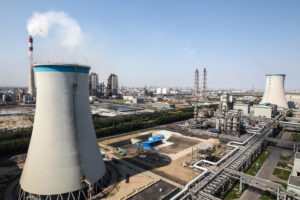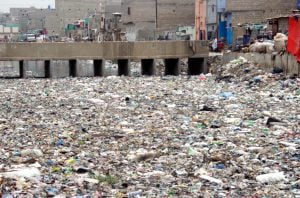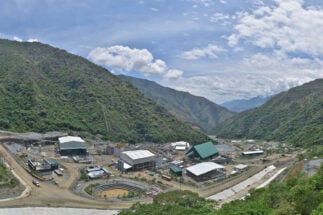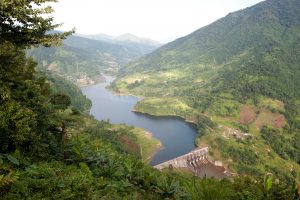Harshvardhan Joshi is on two missions. The first is to climb Mount Everest. The second is to inspire more people to live sustainably. He had planned to embark on a solar-powered expedition to Everest in April, intending along the way to promote awareness of renewable energy and distribute solar panels to remote communities. He has had to postpone this due to the Covid-19 pandemic, but his enthusiasm remains undimmed.
![Using a solar panel to light up tent [image courtesy: Harshvardhan Joshi]](https://dialogue.earth/content/uploads/2020/07/Using-Solar-panel-to-light-up-tent.jpg)
The Third Pole: What does your expedition involve and why?
Harshvardhan Joshi (HJ): It takes around two months to climb Everest. During that time, my climbing Sherpa and I are going to be completely solar powered, and we are going to try to offset the carbon emissions we create. I want to prove that people can have adventures outdoors and travel without degrading the places they visit.
See: Pakistan’s female mountaineering pioneer
The Third Pole: What do you hope your journey will achieve?
HJ: In India, more than 200 million people do not have access to electricity. I want to show that we do not need large solar fields or to depend on governments to improve standards of living: everyone can be self-sufficient, green and save money.
![Solar panels in use at Himlung Himal base camp (2019) [image courtesy: Harshvardhan Joshi]](https://dialogue.earth/content/uploads/2020/07/Solar-Panels-Himlung-Himal-base-camp-2019.jpg)
I’ve called my campaign Sangharsh Mission Mt. Everest, and I want more people to get involved in it. It has already encouraged a few more people to climb mountains – such as Mayur Dumasia, a para athlete I am mentoring, who wants to climb Everest in the next three years.
The Third Pole: How is your expedition “solar powered”?
HJ: I am taking a few 40-watt solar panels with a battery system to power our base camp, which will be home for at least six weeks. Then I’ll take a smaller, portable system up to the second camp at 6,400 metres (21,000 feet). And I will carry a power bank (which will be charged with solar power), until the final camp in the death zone – which will allow me to use my phone and camera at the summit.
Doing this will allow me to calculate how much energy I will use on the trip – as well as my Sherpa guide, team and base camp cooking staff. I’ll be able to offset the carbon I emit during my journey to base camp, for example. If I can use renewable energy in one of the most hostile environments on Earth, it shows we can do wonders being more responsible in cities.
The Third Pole: How can solar power help local communities?
HJ: The Everest region of Khumbu valley is mostly off-grid and does not have much infrastructure.
While I was crowdfunding for my endeavour, a few organisations offered me solar equipment. I sent some panels to my expedition team in Nepal, and the rest were given to those in need. MeraUjala, a company that makes solar panels, donated enough equipment to provide 10 homes with off-grid electricity. With the help of my partners in impact tourism, the panels reached families in some of the most remote regions of the Himalayas: Turtuk and Ladakh in India, and the Makalu region in Nepal. Six systems were donated to the non-profit organisation Shloka Missionaries for the free English school it is building in the village of Dharharwa in Bihar.
![Solar panels on a backpack while trekking [image courtesy: Harshvardhan Joshi]](https://dialogue.earth/content/uploads/2020/07/Solarpanels-on-backpack-while-trekking.png)
After we have reached the summit, I am going to donate the solar panels we use on our expedition to villages along the route that do not have electricity. I also plan to send a few more panels – which will be a personal donation.
While it might seem like a small gesture, it will make a considerable impact in the future. A typical household in India consumes 3-5 kilowatt-hours of power a day. This would translate to a 500 watt to 1 kilowatt solar system. To offset a 1 kilowatt system connected to the electricity grid and using 1,500 kilowatt-hours of electricity annually, you would need to plant over 12,000 square feet of trees every year. Over 30 years, it amounts to planting a nine-acre forest.
The Third Pole: What drew you to the sustainability movement?
HJ: I am an IT engineer from Mumbai, but I have spent most of my time in the Himalayas over the past seven years. I used to be very materialistic and ignorant about sustainability. When I started exploring the Himalayas, I experienced the effects of climate change, which I would not have noticed at home in the city. From spending months in the mountains every year, I learnt that even the most isolated valleys have been touched, and gradually realised the importance of sustainable development.
![At solar partners' warehouse [image courtesy: Harshvardhan Joshi]](https://dialogue.earth/content/uploads/2020/07/at-solar-partners-warehouse.jpg)
HJ: Clean energy is the only way to eradicate poverty and have sustainable development. The beauty of sustainable energy is it democratises health, education and empowers people.
In places where there is no electricity, people lose 12 hours of their time every day – they can’t read, can’t work, can’t communicate with the outside world. Doctors often say that if they had access to energy, they could deliver more services in rural areas. And a remote school having a solar-powered projector means children won’t have to travel for an education.
India has been taking a strong approach to clean energy with “ultra-mega solar plants”. Large makes sense, but only if transmission lines are nearby. For me, decentralised energy is the most sustainable way of providing electricity. It negates transmission and distribution rights and can be customised to the needs and wants of the user.
The Third Pole: What effect will Covid-19 have on the Himalayas? Will environmental pressures be eased?
HJ: Covid-19 has given the world a break, not just the mountains. But most of the mountains are not as dirty as the media suggests – mountaineers on the whole value nature and are conscious about their waste. There is rubbish in some areas due to lack of awareness and facilities, but many people are working to clean it up. Of course, the mountains will benefit if climate change can be slowed down after the pandemic.
Because of the lockdown, I have missed the weather window for climbing the summit this year. I will definitely attempt to climb Everest in 2021.
The Third Pole: What do you think is the energy of the future?
HJ: For the first-time, renewable energy installations have surpassed new coal-powered plants in India. But because India refuses to completely quit coal power, it still uses fossil fuels for over three-quarters of its energy needs. And increasing solar capacity is being undermined by poor policies.
We have the sun available for free and can have clean, cheap electricity. Eventually we are going to have to shift to that, so why not do it now?
![<p>Harshvardhan Joshi is on a mission to help transform mountain climbing into a solar powered adventure [image courtesy: Harshvardhan Joshi]</p>](https://dialogue.earth/content/uploads/2020/07/Stok-Kangri.jpg)







![The Indus at the site of the proposed Diamer-Basha dam [image by: Water and Power Development Authority, Pakistan]](https://dialogue.earth/content/uploads/2020/07/Indus_Diamer_Basha_Dam_Site_Image_WAPDA-300x169.jpg)
